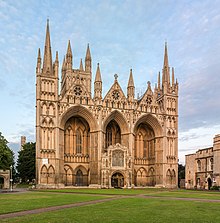
Back Катедрала на Питърбъро Bulgarian পিটারবরা ক্যাথিড্রাল Bengali/Bangla Catedral de Peterborough Catalan Peterboroughská katedrála Czech Kathedrale von Peterborough German Catedral de Peterborough Spanish کلیسای جامع پیتربورو Persian Cathédrale de Peterborough French Katedraal fan Peterborough Frisian Ard-Eaglais Peterborough Irish
| Peterborough Cathedral | |
|---|---|
| Cathedral Church of St Peter, St Paul and St Andrew | |
 Peterborough Cathedral | |
 | |
| 52°34′21″N 0°14′20″W / 52.5725°N 0.238889°W | |
| Location | Peterborough, Cambridgeshire |
| Country | England |
| Denomination | Church of England |
| Previous denomination | Roman Catholic |
| Website | Peterborough Cathedral |
| History | |
| Former name(s) | Peterborough Abbey |
| Dedication | St Peter, St Paul, St Andrew |
| Consecrated | 1238 |
| Architecture | |
| Style | Romanesque/Gothic |
| Years built | 1118–1237 |
| Specifications | |
| Nave length | 147 m (482 ft) |
| Height | 44 m (144 ft) |
| Number of towers | 4 |
| Number of spires | 2 |
| Administration | |
| Province | Canterbury |
| Diocese | Peterborough (since 1542) |
| Clergy | |
| Bishop(s) | Deborah Mary Sellin |
| Dean | Chris Dalliston |
| Subdean | Tim Alban Jones (Vice-Dean) |
| Precentor | Rowan C. Williams |
| Canon(s) | one Diocesan Canon vacancy |
| Canon Missioner | Steve Benoy (designate) |
| Laity | |
| Director of music | Tansy Castledine |
| Organist(s) | Christopher Strange (Organist) Vacant (Organ Scholar) |
Peterborough Cathedral, properly the Cathedral Church of St Peter, St Paul and St Andrew, and formerly known as Peterborough Abbey or St Peter's Abbey, is a cathedral in Peterborough, Cambridgeshire, in the United Kingdom. The seat of the Anglican Bishop of Peterborough, it is dedicated to the Apostles Saint Peter, Saint Paul, and Saint Andrew, whose statues look down from the three high gables of the West Front. Founded in the Anglo-Saxon period as a minster it became one of England's most important Benedictine abbeys, becoming a cathedral only in 1542. Its architecture is mainly Norman, following a rebuilding in the 12th century. Alongside the cathedrals of Durham and Ely, it is one of the most important 12th-century buildings in England to have remained largely intact, despite extensions and restoration, and is one of the nation's best preserved pre-Reformation abbeys.
Peterborough Cathedral is known for its imposing Early English Gothic West Front (façade) which, with its three enormous arches, is without architectural precedent and with no direct successor. The appearance is slightly asymmetrical, as one of the two towers that rise from behind the façade was never completed (the tower on the right as one faces the building), but this is only visible from a distance.